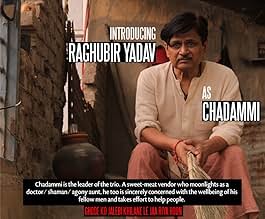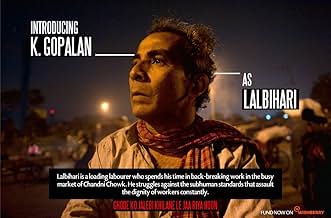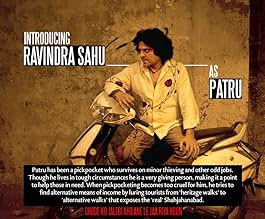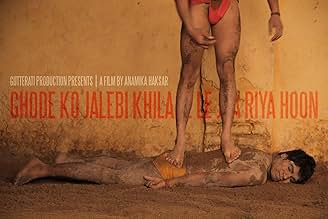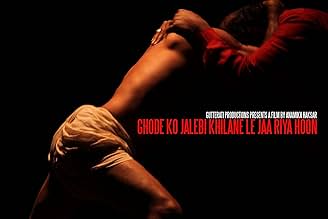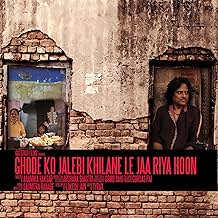A testament of time written in Old Delhi, past and present plotted in its lanes. The narrative moves like a homeless migrant, changing space and structure with each unfolding event, living i... Read allA testament of time written in Old Delhi, past and present plotted in its lanes. The narrative moves like a homeless migrant, changing space and structure with each unfolding event, living in the twilight between the real and the dream.A testament of time written in Old Delhi, past and present plotted in its lanes. The narrative moves like a homeless migrant, changing space and structure with each unfolding event, living in the twilight between the real and the dream.
- Awards
- 3 wins & 9 nominations total
- Director
- Writers
- All cast & crew
- Production, box office & more at IMDbPro
Featured reviews
Showing dreams is the most difficult thing on screen I believe and it's done fantastically. The state of mind depiction is quite perfect. This movie has made me revisit humanity and religion. Heartfelt thanks to the creator to make this film.
A Multilayer cinema where the events develop against the backdrop of dreams, reality, with elements of phantasmagoria intertwined. In fact, we have before us so many dream parables that turned out to be very deep and highly moral and makes you think about problems of human perception. Amidst all the misery in Delhi's Shahjahanabad, one of the conditions to "survive, exist is with the help of dreaming, a friend is thus helping.
Having made an attempt to plunge into the culture of Shahjahanand, director Anamika Haksar begins the movie with a note, as the film launches a whole series of lost character mixing reality and dreams with emphasize on expressiveness and especially brilliant animations. It begins with lot of cuss words thrown in and then the story unfolds before us to a introduce the vicinity filled with sewage water, people sleeping on carts, then we see a man dreaming as he is showered with flowers by Goddess Lakhsmi followed by a surreal scene. The action begins mostly open streets and is gradually transferred to the dream sequences - to the supposed real world of the characters. By the way, I really liked the pickpocket scene with changing hands and it is of these moments that stands out for its staging. Another funny scene is when the thief takes the role of the tour guide for a quick buck and takes help of his imagination and sums the whole theme of the film while taking stroll around the streets. He shows the tourist a shop covered in sheets and sleeping mat. He goes on to open the mat in front of them as we see we little kids lying down as he summarizes that this is the place "where the king and queen and prince all live". I was mostly attracted to the animations that merges in the outlines of the environment, one of the best is in the last 20 minutes of the film as we see women sharing their dreams and innermost secrets and thanks to the animation, the visual combination of editing and camerawork, it is another highlight.
The cast, with the possible exception of Raghubir Yadav, the rest are unknown and this is one of the reasons why the film turned out to be so alive and real as the characters just live. For the very appropriate, close to life casting , the film is supported with humour as it evokes a kind and sincere smile. I would like to highlight the background music which also adds magic in contrasting the monotonous existence, usual way of things as the dreams take charge.
Anamika Haksar gives these lost characters at first glance, a "phantasmagorical" feel with drama, social commentary (mini-Pakistan scene) and philosophy. "Ghode Ko Jalebi Khilane Le Ja Riya Hoon" most of all resembles a kind of surreal experimental documentary which is woven into the story to help the viewer to look at the film from a different angle and your perception will no longer be the same.
Having made an attempt to plunge into the culture of Shahjahanand, director Anamika Haksar begins the movie with a note, as the film launches a whole series of lost character mixing reality and dreams with emphasize on expressiveness and especially brilliant animations. It begins with lot of cuss words thrown in and then the story unfolds before us to a introduce the vicinity filled with sewage water, people sleeping on carts, then we see a man dreaming as he is showered with flowers by Goddess Lakhsmi followed by a surreal scene. The action begins mostly open streets and is gradually transferred to the dream sequences - to the supposed real world of the characters. By the way, I really liked the pickpocket scene with changing hands and it is of these moments that stands out for its staging. Another funny scene is when the thief takes the role of the tour guide for a quick buck and takes help of his imagination and sums the whole theme of the film while taking stroll around the streets. He shows the tourist a shop covered in sheets and sleeping mat. He goes on to open the mat in front of them as we see we little kids lying down as he summarizes that this is the place "where the king and queen and prince all live". I was mostly attracted to the animations that merges in the outlines of the environment, one of the best is in the last 20 minutes of the film as we see women sharing their dreams and innermost secrets and thanks to the animation, the visual combination of editing and camerawork, it is another highlight.
The cast, with the possible exception of Raghubir Yadav, the rest are unknown and this is one of the reasons why the film turned out to be so alive and real as the characters just live. For the very appropriate, close to life casting , the film is supported with humour as it evokes a kind and sincere smile. I would like to highlight the background music which also adds magic in contrasting the monotonous existence, usual way of things as the dreams take charge.
Anamika Haksar gives these lost characters at first glance, a "phantasmagorical" feel with drama, social commentary (mini-Pakistan scene) and philosophy. "Ghode Ko Jalebi Khilane Le Ja Riya Hoon" most of all resembles a kind of surreal experimental documentary which is woven into the story to help the viewer to look at the film from a different angle and your perception will no longer be the same.
What sets Ghode Ko Jalebi Khilane Le Ja Riya Hoon apart from the crowd is its authentic portrayal of everyday life in rural India. The film beautifully captures the essence of small-town charm, depicting the struggles and dreams of its characters with sincerity and depth. The scenic landscapes, vibrant colors, and soulful music transport you into Pari's world, creating an immersive cinematic experience.
The film's heartwarming message of never giving up on one's dreams resonates strongly, reminding us of the importance of determination and perseverance. It encourages viewers to embrace their passions and believe in their abilities, no matter how unconventional or challenging they may seem.
The film's heartwarming message of never giving up on one's dreams resonates strongly, reminding us of the importance of determination and perseverance. It encourages viewers to embrace their passions and believe in their abilities, no matter how unconventional or challenging they may seem.
In the heart of Delhi's Shahjahanabad, amidst the bustling streets and the hardships of its hardworking people, unfolds a cinematic masterpiece that transcends reality. Seamlessly blending dreams, reality, and elements of phantasmagoria, this film takes the audience on an unforgettable journey, prompting profound introspection on human perception and the human condition.
Dreams become a lifeline for survival and existence in the face of adversity, offering solace and hope amidst the misery. Through a series of dream parables, the film imparts deep moral lessons, challenging viewers to ponder the mysteries of life and the complexities of existence.
The director's visionary brilliance shines through every frame, capturing the essence of the setting and the raw emotions of the characters. The film's captivating portrayal of resilience and determination resonates powerfully, drawing the audience deeper into this enchanting tale.
From breathtaking cinematography to stellar performances, this multilayered cinema grips the heart and mind alike. It weaves an intricate tapestry of emotions and aspirations that lingers long after the final scene, leaving viewers mesmerized by the indomitable human spirit.
As the film unfolds, the audience is reminded of the significance of dreams and the profound impact they can have on our lives. Amidst all the struggles, it becomes evident that dreaming is not just an escape but a powerful friend, guiding one through life's challenges.
In conclusion, this cinematic gem is a must-watch for those seeking an intellectually stimulating and emotionally enriching experience. It challenges us to ponder the mysteries of life and reminds us of the power of dreams and the resilience of the human spirit. Don't miss the chance to embark on this extraordinary journey that will leave you deeply moved and pondering life's mysteries long after the credits roll.
Dreams become a lifeline for survival and existence in the face of adversity, offering solace and hope amidst the misery. Through a series of dream parables, the film imparts deep moral lessons, challenging viewers to ponder the mysteries of life and the complexities of existence.
The director's visionary brilliance shines through every frame, capturing the essence of the setting and the raw emotions of the characters. The film's captivating portrayal of resilience and determination resonates powerfully, drawing the audience deeper into this enchanting tale.
From breathtaking cinematography to stellar performances, this multilayered cinema grips the heart and mind alike. It weaves an intricate tapestry of emotions and aspirations that lingers long after the final scene, leaving viewers mesmerized by the indomitable human spirit.
As the film unfolds, the audience is reminded of the significance of dreams and the profound impact they can have on our lives. Amidst all the struggles, it becomes evident that dreaming is not just an escape but a powerful friend, guiding one through life's challenges.
In conclusion, this cinematic gem is a must-watch for those seeking an intellectually stimulating and emotionally enriching experience. It challenges us to ponder the mysteries of life and reminds us of the power of dreams and the resilience of the human spirit. Don't miss the chance to embark on this extraordinary journey that will leave you deeply moved and pondering life's mysteries long after the credits roll.
10mandjas
Anamika Haksar is one of the most talented theatre and film directors. Through 'Ghode Ko Jalebi Khilane Le Ja Riya Hun' (In English the title would sound better by using "to feed" in place of "to eat") she has shown that side of the Old Delhi, which is generally hidden from a routine visiter (be it an Indian or a foreigner). The movie is so realistic that it can pass as a documentary. Anamika has extensively used her theatre techniques and a bit of animation to make her point. At places she actually uses her camera/dialogues to paint an abstract masterpiece. Proud of you, Anamika! Congratulations!
Did you know
- TriviaPremiered in India at Mumbai's MAMI Film Festival in November 2018. International premiere was at Tallinn Black Nights 2018.
- How long is Taking the Horse to Eat Jalebis?Powered by Alexa
Details
- Release date
- Country of origin
- Official sites
- Language
- Also known as
- Taking the Horse to Eat Jalebis
- Filming locations
- Delhi, India(Filming City)
- Production company
- See more company credits at IMDbPro
- Runtime
- 2h 1m(121 min)
- Color
Contribute to this page
Suggest an edit or add missing content


